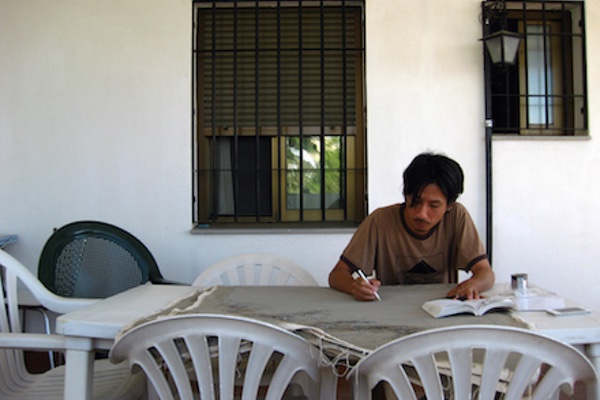“In each place I visited, I studied the local flora and fauna.”
Interview by Emily Jaeger, Features Editor

Yasuaki Okamoto is a New York–based artist. His paintings perform a kind of surrealism that incorporates animals, plants, everyday objects, landscape, and ethereal beings. His work is metaphorically based and inspired by his travels throughout Europe, Asia, and North America.
Jaeger: Incorporated into your surrealist paintings, appearing in our February issue, are lush images of plants, animals, and urban ephemera, among others. What was the origin or inspiration for some of these different images?
Okamoto: I have always been interested in the ecology, so I often use plants and animals as a motif. “Dear Landlord” and “No Littering” also incorporate my interest in investigating social problems: “Dear Landlord” was inspired by the conflict between humans and the environment.

In “No Littering,” I explore the paradox that while many parents may teach their children to not litter, adults create vast amounts of garbage and pollution which contaminates the earth.

Jaeger: Could you talk about the artistic process of combining these conflicting images in your paintings?
Okamoto: Sometimes I depict animals and plants to address the theme of the painting. However, other times, I include animals for the compositional effects of their shapes and colors. I like to use different plants and animals to play with the way the viewer enters and moves in the painting.

For example, in “3:30 AM,” I included two creatures, the tapir and the sheep, to stir the viewer’s imagination. Other animal imagery adds to the dreamlike sensation of this piece: I painted the same birds in a picture on the wall as two that are flying across the room, there is a giraffe pattern visible on the back of the door, etc.

Jaeger: Many of your paintings, such as “3:30AM” and “Dear Landlord,” feature a bright color palette. Could you talk about this artistic choice?
Okamoto: I don’t exactly know why my paintings are so colorful, it just comes naturally to me. However, the difference between my early works and my most recent works is that in my early paintings, I often used primary colors as they were, without mixing in any brown pigment even to paint shadows and dark places. The bright colors in my work also distract the viewer from feeling the darker themes I explore in some of my paintings such as human conflict and natural disasters.
Jaeger: In your artist’s statement, you write: “My work is metaphorically based and inspired by my travel throughout Europe, Asia and North America.” Could you talk more in depth about the role of travel your paintings?
Okamoto: The three pieces in this issue are less related to travel; however, it is an important trope in my work. Before moving to New York, I lived in the United Kingdom, Spain, and Canada. In each place I visited, I studied the endangered species as well as the local flora and fauna. In my work, I don’t like to draw unfamiliar plants and animals, especially if I don’t know anything about their ecology. Therefore, I often draw plants and animals that I have actually seen or sought out.
Jaeger: “Dear Landlord” shows the viewer landscapes above and below the sea in a way that is reminiscent of religious depictions of the divide between underworld, earth, and heaven (cf. “Allegory of Man’s Choice Between Virtue and Vice” by Frans Francken the Younger). How did the compositional structure evolve in this painting?


Okamoto: “Dear Landlord” is a painting about the conflict between human interests and what is best for the land. In the painting, the earth wins the battle but then becomes the battle itself. The composition of the piece is meant to juxtapose the warring earth with the peaceful beauty of the ocean floor.
While I was not familiar with the painting “Allegory of Man’s Choice Between Virtue and Vice” by Frans Francken the Younger while I was working on “Dear Landlord,” I later discovered it at the Boston Museum of Fine Art. I love the composition of Francken’s piece and have explored that type of composition in other paintings.

Jaeger: Which artists have you found to be most influential?
When I lived in London, about sixteen years ago, I discovered Francis Bacon’s work at the Tate Modern, which sparked my interest in painting.
Jaeger: What do you see as some next steps for your work?
Okamoto: Recently I have been exploring the texture of watercolor paintings and studying various kinds of printmaking. I am currently working on a piece that combines these two techniques and would like to continue studying both watercolor and printmaking in the future. I have also never made a three-dimensional piece and would like to try that as well.[gap height=”10″]
Copyright 2017 Woven Tale Press LLC. All Rights Reserved.

